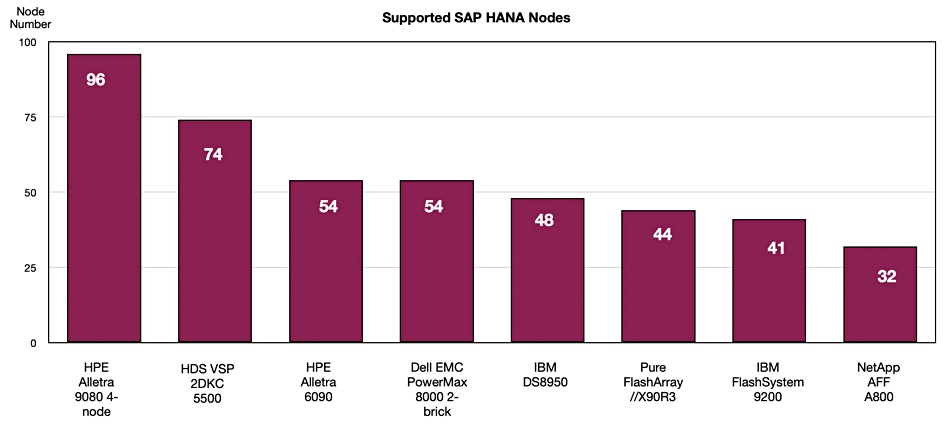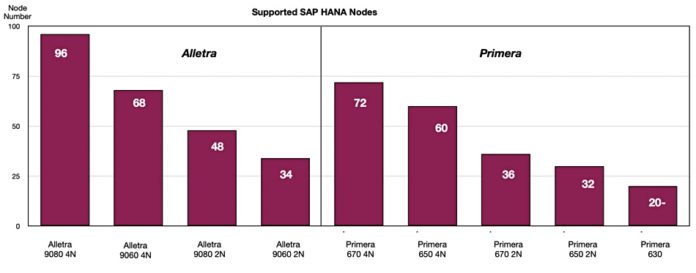Analysis: We have more HPE Alletra‘s features and performance details, after analysing a post by Dimitris Krekoukias. The Nimble exec provided a more informed comparison with the competition, Primera arrays, and a view of the 9000’s branding.
The new Alletra 9000 details we now have are:
- Active Peer Persistence allow “a LUN to be simultaneously read from and written to from two sites synchronously replicating”;
- Multiple parallelised ASICs per controller help out the CPUs with various aspects of I/O handling for the all-NVMe SSDs;
- Vast majority of I/O happens well within 250 microsecond latency;
- Array OS determines what workloads to auto-prioritise
Alletra 9000 and competing arrays
Krekoukias charts the 9000 (and 6000) on a SAP HANA Nodes supported basis, against competing arrays from Hitachi (VSP), Dell EMC (PowerMax), IBM (DS8950, FlashSystem 9200), Pure Storage (FlashArray//X90), and NetApp (AFF A800).

Krekoukias makes much of the 9000’s ability to deliver this performance from its single 4U enclosure. He believes it “makes it the most performance-dense full-feature Tier 0 system in the world (by far).”
He says of the HDS VSP 5500: “The physically smallest possible HDS 5500 shown for comparison would need 18U to achieve 74 nodes. So, the Alletra 9000 can do 30 per cent more speed in 4.5 times less rack space.”
That means it beats HPE’s own XP8, which is an OEM’d HDS VSP 5100/5500 array.
As for Dell EMC’s PowerMax: “A PowerMax 8000 2-Brick (4 controllers) needs 22U and only does 54 nodes. A 3-brick system (6 controllers) can do 80 nodes and takes almost a whole rack (32U). So even with more controllers, a PowerMax needs 8x more rack space to provide less performance than an Alletra 9000!”
There’s more of the same regarding Pure Storage and NetApp.
We were interested in using the data to compare HPE’s Primera arrays with the Alletra 9000. The Primera’s architecture and OS are the basis of the 9000.
Alletra 9000 and Primera
A quick Primera range recap: the current Primera arrays are three all flash models – the 24-slot x 2U x 2-node A630, the 48-slot x 4U x 2-4-node A650, and the A670 – and three hybrid ones: the C630, C650 and C670, all with the same slot, chassis and node details. A node means a controller. The A630 and C630 have a single ASIC per node while the A and C 650 and 670 systems have 4 ASICs per node.
The Alletra 9000 has a 4U chassis like the Primera A and C 650 and 670 arrays.
The ASICs handle zero detect, SHA-256, X/OR, cluster communications, and data movement functions.
Krekoukias writes: “The main difference is how the internal PCI architecture is laid out, and how PCI switches are used. In addition, all media is now using the NVMe protocol. These optimisations have enabled a sizeable performance increase in real-world workloads.”
The blog reveals the number of SAP HANA nodes it supports. We can chart the Alletra 900 and Primera array performance on that basis:

This allows us to directly compare the 9000 models to the equivalent Primera models and work out the performance increase:

The 4-node (controller) models gain a 33.33 per cent speed boost; there were smaller increases for the 2-node models.
Alletra 9000 performance characteristics
As we understand it, an Alletra 9000 system, like a Primera multi-node system, is a cluster in a box. You cannot cluster separate Alletra 9000s together, unlike the Nimble-based Alletra 6000s.
In theory, the only way to scale up Alletra 9000 performance further would be to add more controllers inside a chassis, or to provide some form of interconnect to link separate Alletra 9000s together. Both cases would require hardware and software engineering by HPE.
Without this, having only 4 controllers in its chassis limits the Alletra 9000’s top-end performance, as with Primera. Somewhat embarrassingly, it also uses PCIe gen 3 instead of the twice-as-fast PCIe gen 4 bus (like the Alletra 6000s).
The Alletra 9000s get more performance, per chassis, than the 6000s, even with the slower PCIe Gen 3 bus, as their ASIC hardware accelerates their performance. But cluster the slower 6000 boxes together and they outrun the 9000, reaching 216 SAP HANA nodes supported.
Speeds and feeds
It is a bit of a mystery why the Alletra 9000 didn’t move to AMD processors and the PCIe 4 bus, like the 6000, and gain a greater performance boost over the Primera arrays. That said, the engineering burden would have been greater and taken longer to complete. They would have needed to tune and tweak the ASICs for the new CPUs, and re-engineer the passive backplane to support PCIe Gen 4.
In our view there is an implicit roadmap to a second generation Alletra 9000, using AMD processors and PCIe gen 4. Whether that roadmap contains a larger 9000 chassis to accommodate more nodes, six or eight, is a moot point. So is the addition of a clustering capability, like that of the Alletra 6000.
Without these, faster Dell EMC PowerMax and clustered NetApp AFF systems, as well as clustered 6000s, will be able to outgun the top-end Alletra 9000.
Branding conundrum
It’s clear that, underneath the umbrella Alletra brand, the 9000 and 6000 arrays are different hardware systems with different OS software as well. They are unified by the branding and by the shared management console and ownership/usage experience.
As we understand it, a migration from the 6000 to the 9000 would be a fork-lift upgrade. We have asked if there is an HPE strategy to move to a common hardware/software architecture for the Alletra products.
From a public cloud point of view, where we order storage with particular service levels and characteristics – think S3 variations – the Alletra, like S3, would be an umbrella brand signifying different storage service types available through a unified and consistent front end. The actual hardware/software product details are abstracted away and underneath the AWS customer experience infrastructure.
Seen through this lens, the Alletra branding makes good sense.








